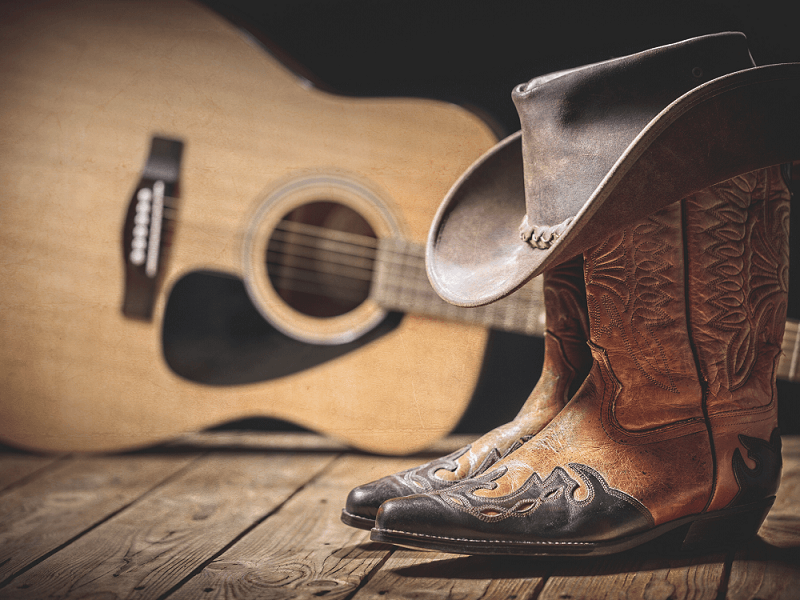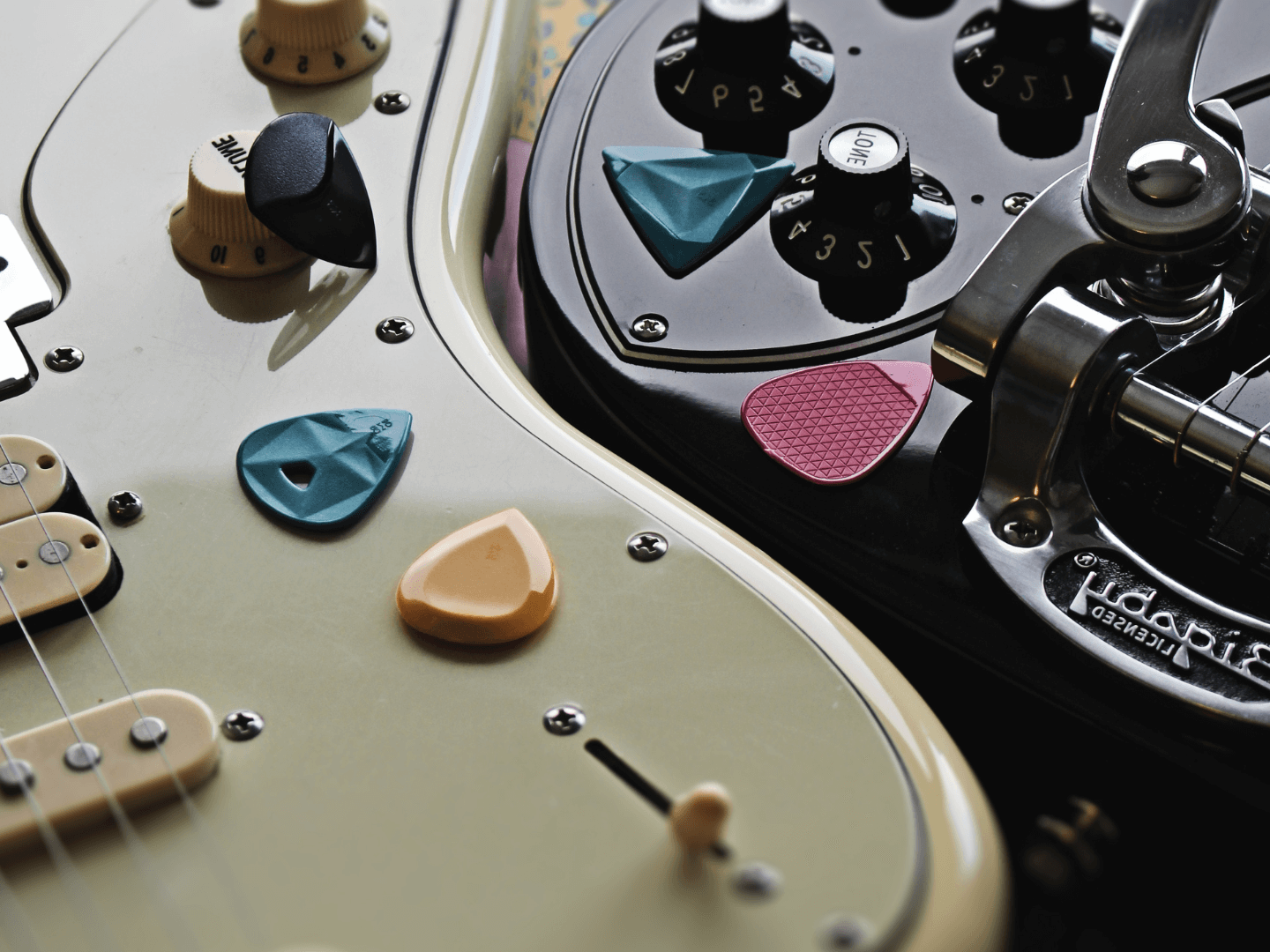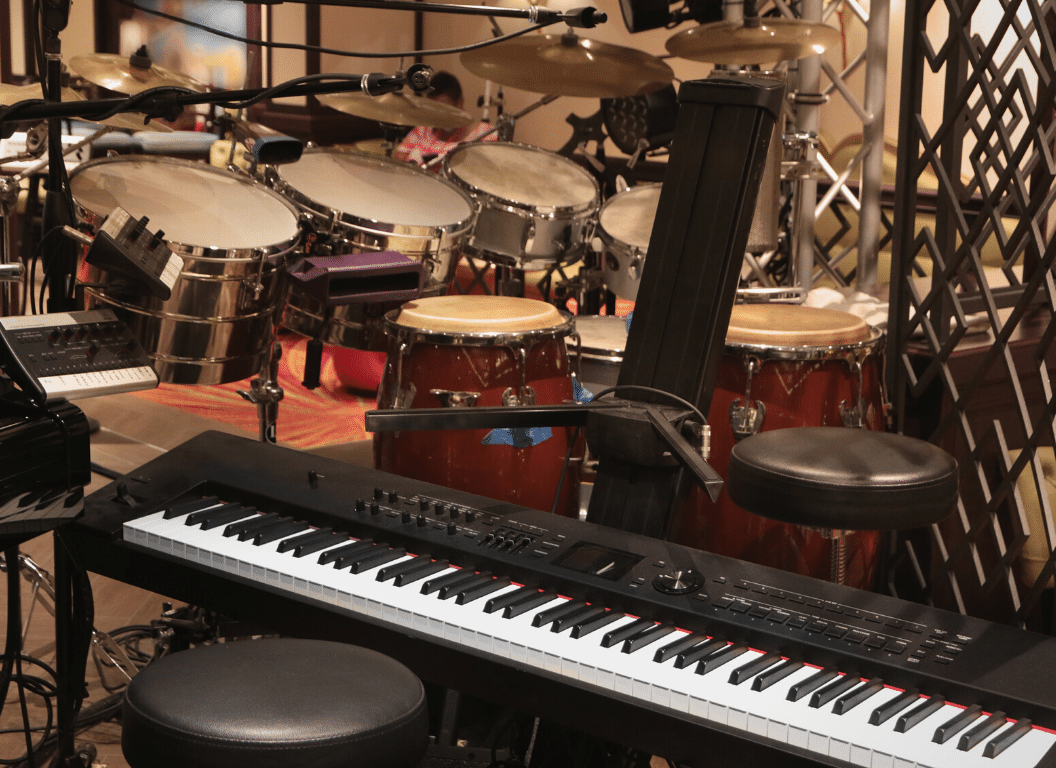There are multiple country chord progressions that people tend to like more than others.
Country music, despite its reputation as simple down-home music to some, is a very rich form of music that any guitar player would benefit from learning.
Its roots come from old-world ballads, gospel songs, and regional folk music in the Appalachians and the American deep south.
In other articles, we’ve talked about the popularity of the I, IV, and V chords, which will be rampant in this type of music.
You’re going to discover how these chords grew into the exciting and soulful type of music that is still as popular as ever.
Aside from that, we’ll go over why these chord progressions work and how you can create your own.
Without further ado, let’s get started!
Table of Contents
- Country Chord Progressions
- I – bIIdim7 – ii7 – IV
- I – I – ii – ii – V7 – V7 – I – (I – V7)
- I – I – IV – IV – V – (V – V7) – I – I
- I (4x) – IV (2x) – I – (I – IV) – I (3x) – (I – vi – V) – IV – V7 – (I – IV) – I
- I – V6 – vi – I6/4 – IV – IV – V – V
- I (8x) – IV (4x) – I (4x) – (V7 – ii) – V7 (3x) – I – I
- I – III7 – (IVmaj7 – vii – I) – (IV – VIIdim – vi) – (Imaj7 – I7) – (VI – VI7) – (II – II7) – V7
- I – I – IV – IV – V – V – I – I
- I – V6 – (vi – I6/4) – (IV – V7)
- (I – VII) – VI7 – (ii – iimaj7) – ii7 – V7 – V7 – (I – bIIdim) – (ii7 – V7 – Vaug7)
- I – iii – IV – I – I – iii – IV – V
- The Chords and Sounds Of Country Music
Country Chord Progressions
I – bIIdim7 – ii7 – IV
The first country chord progression that we’re going to take a look at comes from Garth Brooks’s “Friends In Low Places” in A major.
- A – A#dim7 – Bm7 – D
What’s fascinating about this chord progression is how it adds some subtle sophistication to a pretty basic progression, while also being enormously enjoyable to play and hear.
The A#dim7 chord works in this context because it’s only a note away from an A7 chord.
If we take a closer look at it, it would look something like this:
- A major scale: A – B – C# – D – E – F# – G#
- A7: A – C# – E – G
- A#dim7: A# – C# – E – G
- Bm7: B – D – F# – A
- D: D – F# – A
The A# and G notes add just enough tension while not going too far outside of the key.
On other occasions, you might have heard about diminished chords but this is one of the most basic uses right here.
That is, to take any 7th chord, raise the root by a half step, and use it exactly as you would any other 7th chord.
Definitely not an easy chord to start using, but the others are much easier if you understand the harmonic system being used.
Just so that you can have a better idea, let’s take a listen to it on YouTube:
An easier way to see this whole chord progression is to look at it as an I-IV progression with two other chords adding depth to it.
For those of you that love tabs, here’s what this country chord progression would look like that way:

You can play this progression in multiple guitar fretboard positions, but the simplest way would just be to use as many open chords as possible.
This is especially important with the A and D major chords, which you can use to add more of your personal style to it.
I – I – ii – ii – V7 – V7 – I – (I – V7)
This chord progression can be heard in many popular country songs out there.
In the key of G major for example, it would leave you with:
- G – G – Am – Am – D7 – D7 – G – (G – D7)
If you notice, lots of country progressions will be spread out in 8 or 12 bars.
This number of bars is the standard for many chord progressions in this genre and also even on many pop songs.
One good example of a song that uses this progression is “He Stopped Loving Her Today” by George Jones:
You should recognize and know most of these chords if you’ve been playing for a while.
All of them can be played using open chord shapes, so you’ll definitely have room to improvise and add your own phrasing to it.

When you understand key signatures and how they helps find the chords that are often used together, it’s easy to see how this and many other chord progressions work.
Let’s break the G major scale down for reference:
- G major scale: G – A – B – C – D – E – F#
- G major chord (I): G – B – D
- Am chord (ii): A – C – E
- D7 chord (V7): D – F# – A – C
As you can see, all the notes in each of these chords use in one way or another 3-4 notes from the G major scale.
Every single major key will have one dominant 7th chord that naturally occurs.
If you wanted to add other chords to this progression, a good start would be to use some of the notes in the scale (G – A – B – C – D – E – F#).
I – I – IV – IV – V – (V – V7) – I – I
This chord progression is Buck Owen’s “I’ve Got A Tiger By The Tail” in C major:
C – C – F – F – G – (G – G7) – C – C

This is the first straight-up example of I-IV-V we’ve seen so far after all the buildup.
Remember that you will see this a lot in some form, whether it’s a straight-forward 1-4-5 or a 1-4-5 that’s in disguise.
This progression also uses the V7 I talked about in the previous section.
This is a crucial building block of many country progressions so it’s important to highlight it.
- C major scale: C – D – E – F – G – A – B
- C major chord (I): C – E – G
- F major chord (IV): F – A – C
- G7 chord (V7): G – B – D – F
Every major key has a V7 because, when you build a chord off the fifth note (G), you will have a minor 7th interval (the note F) available to use from the key.
A minor 7th interval can be built off any root note by using the note that’s a whole step below the root note (G to F, one whole step below).
Does that make sense? If so, you’ve just unlocked an important part of understanding major key harmony and country music.
Every key will have a V7, and every chord has a relative V7 you can use.
I (4x) – IV (2x) – I – (I – IV) – I (3x) – (I – vi – V) – IV – V7 – (I – IV) – I
This extremely popular chord progression comes from “Will The Circle Be Unbroken” by the Carter Family in G major:
G – G – G – G – C – C – G – (G – C) – G – G – G – (G – Em – D) – C – D7 – (G – C) – G (16 bars)


How many aspects of songwriting can you spot that we’ve gone over before?
You should see all the commonly used chords of G major, the semi-blues structure, and the V7 again.
The big reoccurrence though is that it uses all common open chords.
One aspect of this progression that we haven’t touched on is the use of several chords per bar; like every other aspect of songwriting and theory, there are no set rules.
However, there are some best practices!
It’s best to have only one chord change per bar, although you’ll see a bar above that has two chord changes (G-Em-D).
Because of your knowledge of key signatures, you should know that you can use nearly anything available through the notes of the G major scale.
Keeping one chord per bar only makes the process of arranging and creating melodies much easier.
I – V6 – vi – I6/4 – IV – IV – V – V
This is Brad Paisley’s “Mud On The Tires” in D major:
- D – A/C# – Bm – D/A – G – G – A – A

The very first thing you noticed probably is that I marked the A/C# as V6 and I6/4.
In guitar playing we normally refer to these chords as inversions or drop 2/3 chords.
What I’m using refers to the method of analyzing classical music where a 6 chord has a third in the bass while a chord with fifth in the bass has a 6/4.
To make it as simple as possible though, A/C# is just an chord with C# in the bass.
C# is the major 3rd of an A major chord. So same thing is happening with the D/A as the A is in the bass of a D major chord.
What makes these chords fascinating is how little they’re used in guitar music compared to other instruments and genres.
A whole world of musical harmony is yet to be explored because we settle for using pre-determined chord shapes.
I (8x) – IV (4x) – I (4x) – (V7 – ii) – V7 (3x) – I – I
This is a 12 bar blues progression that makes up Johnny Cash’s “Folsom Prison Blues” in G major:
- G (8 bars) – C (4 bars) – G (4 bars) – (D7 – Am) – D7 – D7 – D7 – G – G


In other articles we’ve covered what a 12 bar blues is but we’re happy to discuss it again. It’s referring to a set harmonic structure that’s played out over 12 bars.
I’ve mentioned several times how prominent the I, IV, and V chords are. That’s because a lot of it descends from this structure.
To play a blues like this song, just chose a song and follow the same number of repeated chords: I 4x, IV 2x, I 3x, V, IV, and then I.
Yes the progression above is 22 bars long, but it somewhat follows the structure I just mentioned…
I – III7 – (IVmaj7 – vii – I) – (IV – VIIdim – vi) – (Imaj7 – I7) – (VI – VI7) – (II – II7) – V7
This is Tammy Wynette’s “Stand By Your Man” in Bb Major:
- Bb – D7 – (Ebmaj7 – Abm/Eb – Bb/Eb) – (Eb6 – Adim/Eb – Gm/Eb) – (Bbmaj7 – Bb7) – (Gsus4 – G7) – (Csus4 – C7) – F7

This chord progression will be the “busiest” one we’ll talk about. It’s using up to 3 chords a bar, and is often going out of the key of Bb major:
- Bb major scale: Bb – C – D – Eb – F – G – A
- Bb chord: Bb – D – F
- Ebmaj7: Eb – G – Bb – D
- F7: F – A – C – Eb
D7, Abm/Eb, Bb7, C7, and G7 don’t belong in the key of Bb major.
It may be hard to see this as Bb major is not used often in rock or pop music, let alone country music.
Just like every other chord progression though, this one has a set of chords that can be created with the 7 notes available.
The way to understand this progressions choices to use these chords is to understand the V to I chord change. Eb is the V to Abm. G7 is the V to C. C7 is the V to I.
So why D7 and Bb7? Well it’s because D7 is the V to G, and Bb7 is the V to Eb.
Let’s compare the chords:
- D7: D – F# – A – C
- Ebmaj7: Eb – G – Bb – D
- Gm7: G – Bb – D – F
- Bb7: Bb – D – F – Ab
- Gsus4: G – B – D – F – C
- Ebmaj7: Eb – G – Bb – D
Ebmaj7 has many of the same chords as Gm7, while Gsus4 has many of the same notes as Ebmaj7.
I – I – IV – IV – V – V – I – I
This is Tim McGraw’s “I Like It I Love It” in C major
- C – C – F – F – G – G – C – C

This one is much easier than the previous one right?
You can get complex and go outside the key whenever you want to, but oftentimes this is all you’ll need for a country song. Just a good old I-IV-V.
I – V6 – (vi – I6/4) – (IV – V7)
Now we’re finally doing one of Willie Nelson’s songs with “Always On My Mind” in D Major:
- D – A/C# – (Bm – D/A) – (G – A7)

Thankfully we’ve already gone over the V6 and I6/4 chords.
Look at this as another model for inverted chords.
However also be mindful of how you don’t have to stick so closely to I-IV-V either.
This progression and others will often use iii, vi, and ii as well in between those chords.
(I – VII) – VI7 – (ii – iimaj7) – ii7 – V7 – V7 – (I – bIIdim) – (ii7 – V7 – Vaug7)
This chord progression is Patsy Cline’s “Crazy” in Eb major:
- (Eb – Db) – C7 – (Fm – Fmmaj7) – Fm7 – Bb7 – Bb7 – (Eb – Edim) – (Fm7 – Bb7 – Bb7#5)

Since this was written by Willie Nelson, who was a big Jazz fan, it’s necessary to understand why some progressions like this exist in country music.
The reason we use chords other than I, IV, and V is because they don’t express all the emotions needed. Sometimes its necessary to go out of the key, and using the VII and bII are some of the best to use.
Why VII? Because it allows us to setup the ii as a temporary key center, or rather to change keys to F minor.
There is a whole world of musical knowledge that comes from changing keys and using chords from other closely related keys, but the VII is a good one to use for this purpose.
The bII is used often to take advantage of the parallel minor mode, where the ii is a diminished chord. To see why the bII works well going to Fm7, you need to see how similar it is to C7:
- C7: C – E – G – Bb
- Edim: E – G – Bb
- Eb: Eb – G – Bb
This is why it’s necessary to learn all the notes of each chord!
I – iii – IV – I – I – iii – IV – V
The last song we’ll cover is George Strait’s “Amarillo By Morning” in D major:
- D – F#m – G – D – D – F#m – G – A

No more talk of chromatic harmony and modulation right here.
Just another 1-4-5 in disguise with a iii added onto it.
The Chords and Sounds Of Country Music
In country music, you’re going to see a lot of chord progressions in major keys. This is because major keys are the backbone of lots and lots of popular music.
To better understand this, it’s time to look at the I, IV, and V chords in more detail and see why the ears of these great songwriters tended to gravitate to these harmonies.
Let’s use the key of G major to illustrate these concepts: (W = whole step while H = half step)
- G major scale: G (W) A (W) B (H) C (W) D (W) E (W) F# (H) G
- G chord (I): G – B – D
- C chord (IV): C – E – G
- D chord (V): D – F# – A
All of the notes of these chords comes from the major scale as set by the formula of whole and half steps.
You’ll probably have more questions but try to understand that this is the fundamental building block of lots of music.
It’s the foundation, the framework, and the steel beams holding up the rest of the song structure.
If you’ve ever heard anyone say that “all you need is three chords” then this is what they really meant.
Of course there’s a lot more than three chords, but putting them together according to this widely used harmonic system is really all you need for Country guitar and many others as well.
Blues, Jazz, Reggae, Pop, and Rock all use some combination and some pattern of the I, IV, and V chords.
Along with this harmonic system, you’ll be using lots of dominant 7th chords like A7, D7, G7, etc.
You’ll see some diminished chords and some jazz chords, but most of the progressions you’ll see will focus around the sound of that chord type and the I, IV, V chords.
Of course, lots of open chords like G, C, D, A, and E will be used too.
Loves studying classical piano, youtube video tabs, and music theory textbooks to get insights into guitar playing that no one else has uncovered yet. In his spare time, he can be found relaxing at the beach in San Diego, or adventuring somewhere around the world.




